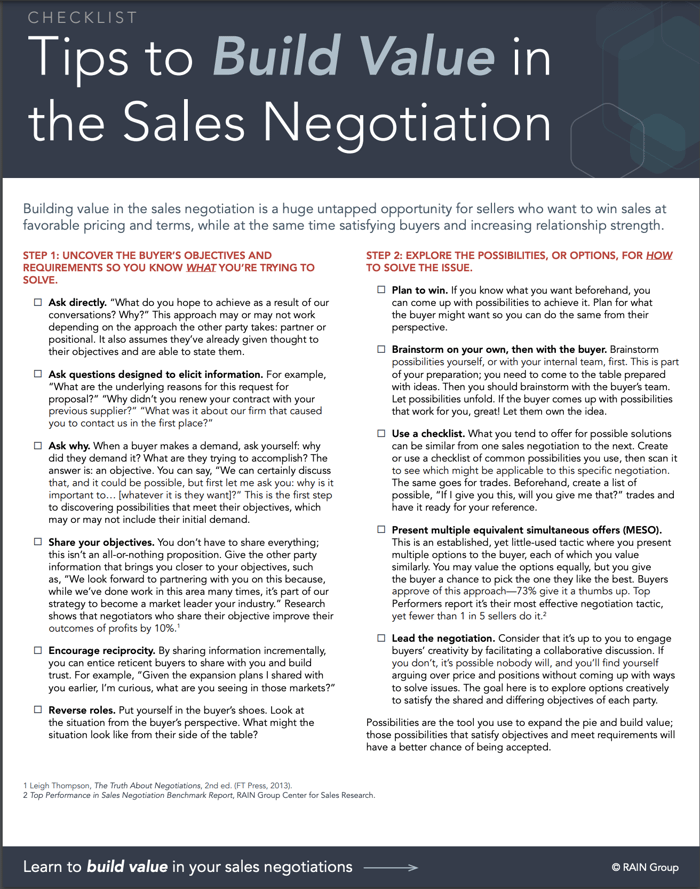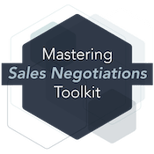In our research report, The Value Driving Difference, we studied almost 500 organizations' practices regarding how focused they are on driving value for buyers. Companies that rose to the top as Value-Driving Sales Organizations had higher sales win rates, were more likely to grow revenue, had lower undesired sales staff turnover, and much more highly motivated sellers. They were also two times more likely to agree that they capture maximum prices in line with their value.
There's no question: If you want to succeed in sales, you should focus on driving value.
However, almost all sales organizations that do focus on value do so during core selling activities: discovering need, bringing ideas to the table, and crafting compelling solutions.
Little attention is paid to driving value during sales negotiation. This is a huge, untapped opportunity for sellers who want to win sales at favorable pricing and terms, and do so while satisfying buyers and increasing relationship strength.
Essential Rule of Sales Negotiation #2: Build Value
Brainstorm new possibilities for coming to an agreement.Driving value during negotiation is also a major factor for not losing sales that you should have won. The more the buyer values moving forward and doing so with you, the more likely they are to do so. In addition, our sales negotiation research revealed that 62% of buyers agree that they have the flexibility to pay more for a solution if the seller demonstrates that it's worth it.
There's money on the table, and sellers can claim it by building value. With a thorough needs discovery, you can learn what problem the buyer is trying to solve.
Then you can explore the possibilities, or options, for how to solve the issue.
Use our checklist, Tips to Build Value in Sales Negotiation, to help you think about how you want to approach value building in negotiation situations. Read on for best practices on establishing a value case.
Click here to download the checklist (PDF)
There are two keys to unlocking value in a negotiation: 1) using structure and constraints and 2) collaboration.
1. Use structure and constraints
Coming to agreement in a negotiation requires addressing the negotiated issue in a systematic way. The negotiated issue can be broken down into the following four components:
- Objectives: The goals you and your buyer are working to achieve
- Possibilities: The components of the solution you craft to achieve both parties' objectives
- Requirements: Guidelines or rules you and the buyer must follow in order to move forward with an agreement
- Alternatives: What you and the buyer can do if you choose not to move forward with an agreement
The Negotiated Issue
 A thorough and mutual understanding of objectives and requirements allow you to create the most valuable possibilities.
A thorough and mutual understanding of objectives and requirements allow you to create the most valuable possibilities.
In negotiations, you have tactical considerations like price, volume, contract length, terms and conditions, and roles and responsibilities, and strategic considerations like the overall solution and implementation plan.
Too many sellers enter a negotiation without considering objectives and requirements carefully enough before they propose possibilities for coming to agreement. This happens with individual points a buyer may raise (tactical) and for the sale overall (strategic). For example, a buyer may raise a price objection, or suggest cutting a part of the proposed solution in order to keep costs down.
Seller responses to price objections are too often "Where do we need to be?" or some other response that focuses on cutting the price. Seller responses to buyer requests for scope reduction are too often "Okay, here is a new solution and a new lower cost."
Instead, sellers should think about and overtly shift the discussion to objectives. In the first case, instead of cutting price, the seller should focus on understanding why the buyer is pushing back. Is it a budget or availability of funds issue? Is it that the buyer doesn't see the value? Perhaps the buyer is simply testing whether the seller will cave under pressure. Money objections come in 6 flavors. Unless you know what the buyer's objective is, you can't come up with a solution that will satisfy them.
Think Objectives Over Objections
In the second case (scope reduction), the seller would be better served thinking about and addressing objectives. For example, the seller might say, "Well, we can certainly reduce the scope as a possibility, but before we do that, let's review what you are trying to accomplish by moving forward. If we cut A, that will prevent us from achieving B. Is it worth it to reduce the scope by $X to do that? Or can we achieve B another way? Let’s think it through."
Do this and you may find another way to achieve B. However, what often happens is the buyer sees it's not a good idea to cut scope and pursues the original larger purchase.
Without a full understanding of objectives and requirements, the capacity to build value is limited. Not only are objectives the underpinnings of the positions that the buyer might take at any time (e.g. the price objection), objectives are the scaffolding for your construction of the final agreement.
Knowledge of objectives and requirements allows you to create possibilities that buyers will value and, at the same time, make you distinct and more valuable than the alternatives.
When it comes to creativity, we often picture unrestrained imagination: freedom in all directions. Surely you want to be "breaking the mold" and thinking "outside of the box" to come up with new possibilities?
The truth is: creativity depends on constraints. You need to know the box you're playing in to break out of it. Artists know this well. In her book Creativity from Constraints, the Psychology of Breakthrough, Dr. Patricia Stokes looks for the common thread that unites great leaps forward in the arts. Her conclusion: "From Picasso to Stravinsky, Kundera and Chanel to Frank Lloyd Wright, it is not boundary-less creative freedom that inspires new ideas, but self-imposed, well-considered constraints."
Approaching the negotiated issue with this structure—defining all your constraints and meeting obstacles head on—is the key to generating breakthroughs that move the process forward and increase likelihood of winning the sale at favorable pricing.
Consider the following study conducted by social psychologists at the University of Amsterdam:
Participants were asked to play a maze game. Some participants sped right through to the end of the maze with no obstacles. Others encountered a frustrating obstacle which limited the number of routes to escape the maze.
When the two groups of maze participants were then given a word test (example: find a word that connects "dust," "cereal," and "fish"*), the obstacle group was 40% better at coming up with solutions. Constraints, barriers, and limitations encourage us to step back and look at the big picture. This allows us to make connections between things that are not obviously connected when we're zoomed in on details.1
Use structure and constraints when addressing the negotiated issue. Know the objectives and requirements of both sides in order to maximize creative output, find the best possibilities, and build value.
2. Collaborate
We at the RAIN Group Center for Sales Research recently studied more than 700 business-to-business purchases made across industries by buyers who represent a total of $3.1 billion in annual purchasing power. Our goal was to find out what the winners of these major sales did differently from the sellers who came in second place.
We found that the sellers who ultimately win the sale don't just sell differently—they sell radically differently than the closest second-place finishers.
A major finding of this research is that the sellers who win collaborate with buyers significantly more often than those that lose. Not only does collaboration help sellers win sales, it also helps them negotiate the best agreements at favorable pricing.
Collaboration is powerful and persuasive, yet it's often underutilized as an influence on decision making and buying. When collaboration happens, sellers:
- Effect emotions in the buyer that support negotiation success, inspiring buyers to feel connected, engaged, respected, and valued
- Deepen relationships and trust which leads to better negotiated solutions2
- Deepen understanding of objectives and requirements which, as noted previously, sparks insight and innovation thus strengthening the quality and applicability of solutions
- Differentiate themselves in the minds of buyers (because most sellers don't collaborate with buyers), thus creating negotiation leverage as alternatives become less attractive
- Create a sense of psychological ownership in buyers
To the last point: when a seller proposes a possibility without collaborating, I always picture in my mind's eye a gladiator in front of a Roman Emperor, waiting to get the thumbs up or down verdict on their life. Similarly, when a seller simply pitches ideas it's like a dog and pony show. The buyer is the judge but doesn't feel any particular attachment to the seller's proposals or coming to agreement.
It shouldn't be like that. It doesn't need to be like that.
When sellers collaborate, they build the buyer's psychological ownership of the issue so that buyers become invested in coming to an agreement. Indeed, they actually value coming to an agreement simply through the process of collaborating. (Note: Most people think collaborating and negotiating are better addressed live and in person. In fact, doing so online often works great.)
At the same time, strong collaboration helps buyers see things in ways they hadn't considered previously. When sellers can redefine buyer thinking and improve buyer decision making, the seller becomes much more valuable to buyers as well.
Learn about the other Essential Rules of Sales Negotiation:
- Essential Rule of Sales Negotiation #1: Always be Willing to Walk
- Essential Rule of Sales Negotiation #3: Lead the Negotiation
- Essential Rule of Sales Negotiation #4: Effect Emotions
- Essential Rule of Sales Negotiation #5: Trade, Don't Cave
- Essential Rule of Sales Negotiation #6: Plan to Win
*Answer: Bowl
1 Janina Marguc, Jens Forster, and Gerben A. Van Kleef, “Stepping Back to See the Big Picture: When Obstacles Elicit Global Processing,” Attitudes and Social Cognition 101, no. 5 (2011): 883-901.
2 Roy J. Lewicki and Beth Polin, “The role of trust in negotiation processes,” in Handbook of Advances in Trust Research, ed. Reinhard Bachmann & Akbar Zaheer (Cheltenham: Edward Elgar Publishing, 2013), 29-51.








